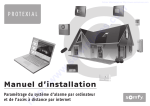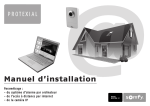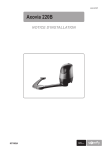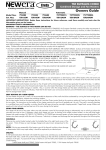Download HERE - CPAP PRO Parts
Transcript
DCC#13-214 CPAP PRO PARTs DIAGRAM 1. 2. 1. NASAL PUFF 3. PART #2 2. DIFFUSERS PART #7 5. 4. 6. 3. MOUTHPIECE PART #1 4. HOSE CLAMPS PART #3 5. CURVED BRACKET PART #4 6. SCREW & NUTS PART #8 7. 7. CORRUGATED TUBES PART #5 8. “Y”-COUPLING PART #6 8. PLEASE READ THIS INFORMATION CAREFULLY! INTENDED USE: The CPAP PRO CPAP interface is intended to treat adult obstructive sleep apnea (OSA). CAUTION: In the USA, federal law restricts this device to sale by, or on order of a physician. NOTE: The CPAP PRO does not contain latex materials. If you have ANY reaction to any part of the system, discontinue use and consult your sleep therapist or physician. WARNING: CPAP PRO should be used only with CPAP or bi-level systems prescribed by your physician or respiratory therapist. It should not be used unless the CPAP or bi-level system is turned on and operating. The exhalation ports and diffusers should never be blocked. As part of this transaction, we would like to make certain that you and our company, CPAP PRO, a division of Stevenson Industries, Inc. are in complete agreement with the terms of this sale. No warranties are made or implied that you will find CPAP PRO to be more suitable for the treatment of your sleep apnea in comparison to cpap masks and other nasal devices that you may or may not have utilized, since the comfort level of each cpap breathing device is a matter of personal individual preference and cannot be predicted prior to actual use by the patient. All information provided to you through any means of communication is for informational purposes only and is not a substitute for professional medical advice. Only your healthcare provider should diagnose your healthcare problems and prescribe treatment. All product information should be read thoroughly prior to purchase and use. If you have or suspect you have a medical problem, consult with your healthcare provider. Your CPAP PRO kit includes data on two methods of forming a dental mouthpiece with a dental impression of your upper teeth. The choice as to which method you choose to utilize is your sole decision based on your own and your physician’s evaluation of your physical and emotional 1. condition as well as your ability to understand the necessary procedural steps concerning the safety and instructions to properly form fit the dental mouthpiece. If you have any serious problems whatsoever concerning the condition of your teeth, gums, or mouth such as, but not limited to loose fillings, removable bridges, dentures, sore gum problems, or any other physiological problems such as TMJ or sensitivity to hot liquids or foods you should not utilize CPAP PRO without consulting with your physician or dentist to determine if CPAP PRO can safely be used by you. During periodic visits to your dentist, for evaluation purposes, indicate that you are utilizing a dental appliances nightly. If you experience any dental problems during the use of this product, discontinue use immediately and consult with your dentist of sleep specialist. It is possible to prepare the customized dental mouthpiece utilizing what is commonly known as the “boil ‘n bite” method. This will require your use of boiling water to soften the impression material and insertion of the heated mouthpiece into your mouth to press the softened filler material with sufficient pressure up against your upper teeth to make a dental impression of your teeth. If you choose to utilize the boil ‘n bite method utilizing boiling water, please be aware that we assume no responsibility for any injury or damage that may occur due to the handling of these hot liquids and materials. As an alternative to the boil ‘n bite method there is a customized dental mouthpiece available using conventional dental impression procedures. This procedure would be done by your dentist after an evaluation to determine if a customized mouthpiece is appropriate for you. Please contact Stevenson Industries, Inc. to obtain information explaining the procedure and the necessary items for your dentist to utilize for this fitting procedure. We offer no recommendation as to which fitting procedure would be best suited for your particular needs. The boil ‘n bite mouthpiece is designed to fit most patients; however in some instances, in order to achieve maximum comfort a customized dental mouthpiece may be required. Read carefully the descriptive literature and consult with your healthcare professional concerning the two fitting procedures to determine which method is recommended for your needs. 2. CUSTOM FORMING YOUR BOIL ‘N BITE MOUTH PIECE (BRUSH TEETH BEFORE FORMING MOUTHPIECE!) 1. Prior to disassembling your CPAP PRO make note of the assembly so that you can reassemble properly after forming the mouthpiece. Please note that the two corrugated tubes face towards your mouthpiece rather than outwards! 2. Unscrew the dental mouthpiece bracket, which is held in place by two white nylon screws. Be sure to save the screws and nuts! 3. Place the mouthpiece in a small pot and add enough water to cover the mouthpiece by at least two inches of water. 4. Heat the water and mouthpiece so that the water comes to a rolling boil. 3. 5. Remove pot from heat. 6. Place thermometer tip in water to determine water temperature. 7. When the water cools and the thermometer reads 140F-150F or 60C-65C degrees, carefully remove the mouthpiece with tongs. 8. Shake off excess water. 4. 9. Make certain that the mouthpiece is not too hot to place in your mouth. If you are sensitive to hot liquids or hot foods consult with your physician prior to proceeding. Using a mirror, quickly center the mouthpiece bracket directly under your nose and place the heated mouthpiece up against your upper teeth (with front teeth as far forward as possible in mouthpiece.) 10. With fingers and thumbs exert as much pressure as possible upwards to force your teeth firmly into impression material. 11. Your teeth should actually touch the bottom of the mouthpiece tray. Bite down firmly on the mouthpiece to form the impression. 12. VERY IMPORTANT! Do not remove the mouthpiece for approximately 5 minutes so that the filler material can cool down and solidify. If you remove it too soon, you will not have a good impression of your upper teeth and the mouthpiece will not stay affixed to your upper teeth. 13. Gently remove the mouthpiece from your upper teeth. 5. 14. While the mouthpiece is still warm use small or rounded scissors to trim off the filler material. Save trimmed filler material to use if you need to re-form the mouthpiece. IMPORTANT! Do not trim the filler material that extends out the back of the tray around the last tooth; simply flatten and smooth. 15. Let your mouthpiece reach room temperature and harden. You can speed the process by dipping it in ice water. 16. Check the fit of your mouthpiece. It should press comfortably onto your upper teeth and stay in place. If it is too loose, you can reheat the mouthpiece, flatten out the filler material and redo the entire process. 6. 17. Now that you have made your mouthpiece, we suggest that prior to reassembling your CPAP PRO, you get comfortable with having it in your mouth by wearing it while watching TV or reading the newspaper, etc. for a few hours daily. Initially, some patients accumulate an excess amount of saliva in their mouth. With continued use, this problem will end. 18. Reconnect the mouthpiece to the curved bracket with the two corrugated tubes facing towards the mouthpiece. (Refer to the CPAP PRO Parts Diagram) CAUTION: The corrugated respiratory tubes are designed for maximum patient comfort and many months of use. Do not damage these tubes by pulling or kinking them! Adjusting Your CPAP PRO For Personal Use 19. Open the tube holder clamps (Part # 3 Hose Clamps) by sliding one end upward and the other end downward. A sample hose clamp is enclosed for practice. TO OPEN CLAMP: SLIDE ONE END UP AND THE OTHER END DOWN TO CLOSE CLAMP: SQUEEZE TIGHTLY 20. While looking into a mirror with the mouthpiece affixed to your upper teeth, gently slide the two corrugated tubes upward or downward to press the nasal puffs against the nostrils to form a good seal to prevent leakage. 21. When the nasal puffs are in the proper position with your nostrils, tightly squeeze the hose clamps to lock the corrugated tubes into position. 7. 22. For most patients, having the two tube holder clamps in the extreme outward position of the curved bracket (Part # 4) is the most comfortable position; however, the hose clamps can be repositioned by sliding them inward, if necessary. 23. PLEASE NOTE THAT IN ORDER TO KEEP THE NASAL PUFFS IN PLACE WITH THE NOSTRILS, THE HOSE CLAMPS MUST BE POINTING TOWARDS ONE ANOTHER. 24. Connect to CPAP machine and evaluate CPAP PRO fitting. If there is excess leakage, the nasal puffs can be readjusted to apply more pressure to the nostrils. If the nasal puffs spring outward from the nostrils, adjust the hose clamps to a more extreme vertical angle. Additional Suggestions! It will take several days or even weeks to get used to your CPAP PRO, just as it does with other CPAP interfaces, be patient and persevere! 8. Swivel Connector The Swivel Connector attaches to the Y-Coupling (Part #8). The Swivel Connector assists in connecting the CPAP PRO to CPAP tubing and helps prevent kinks in the CPAP hose. This allows for additional comfort by increasing the ability to toss and turn trouble free. This item is optional and not necessary for proper CPAP PRO use. Cleaning Instructions! DAILY: Wash the CPAP PRO with warm, soapy water. Do not use soaps with added scents. We recommend plain dishwashing liquid soap or baby shampoo. Rinse well and allow to air dry out of direct sunlight. Clean air outlet tips of Nasal Puffs (Part #2) with alcohol. Do not use alcohol on any other components. Mouthpiece: Clean nightly with only a cold water dental cleanser, such as ACTIPRO™. DO NOT USE HOT WATER! Rinse thoroughly. It is not necessary to disassemble the CPAP PRO to clean the mouthpiece. WEEKLY: Separate and hand wash the components in warm, soapy water. Do not use soaps with added scents. Rinse the components well and allow them to air dry out of direct sunlight. Caution: It is essential that after cleaning, the nasal puffs and the corrugated tubing are both perfectly dry. If not, the nasal puffs may slip off tubing! 9. Caution: Do not use solutions containing vinegar, bleach, chlorine, aromatics, moisturizers, antibacterial agents, or scented oils to clean any part of the system. These solutions may cause damage and reduce the life of the product. Do not expose any part of the system or tubing to direct sunlight as it may deteriorate the product. If any visible deterioration of a component is apparent (cracking, tears, etc.), the component should be discarded and replaced. Wash your face before bedtime to eliminate slipping and sliding of the nasal puffs. Do not use any creams or ointments on nostrils or nasal puffs. Inspection and Replacement: Proper care and usage should result in long trouble free utilization of your CPAP PRO. However, daily inspection and prompt replacement of any part showing wear or damage is required. Upon receipt and before use, carefully inspect all parts and tubing for visual defects and signs of wear or damage. Check the ends of the tubes and fittings for signs of cracks and splitting. The tubing should be free of stains and discoloration. Replace any parts of tubing if evidence of wear, cracking, staining or discoloration is noted. 10. replacing exhalation diffusers part #7 PLEASE NOTE! The CPAP PRO nasal interface has been designed for maximum patient comfort and long term use. In order to avoid damage, it is essential that there be no undue strain, pulling or kinking of the respiratory corrugated tubing. Caution: when replacing Exhalation Diffusers, do not pull on tubing; grasp diffusers to remove tubing from nasal puffs as illustrated on the next page! The foam diffusers directly below the nasal puffs are extremely important for safe exhalation. They must be kept clean and dry and should be replaced at least monthly. Soaking the tubing in warm water prior to separating the nasal puffs from the tubing will make it much easier to separate the components. The foam diffusers should be cleaned along with your CPAP PRO in warm water with some dishwashing liquid detergent. Be sure to rinse your complete CPAP PRO in clear water. 11. In order not to damage the corrugated tubes (Part #5), the nasal puff assembly should be gently removed from the corrugated tubing for green foam diffuser replacement by using a gentle rocking motion to separate the nasal puff from the tubing. With pressure exerted only on the nasal puff and on the diffuser – NOT THE TUBING! When removed, slide new diffuser over exhalation hole and gently press the nasal puff component into place. NASAL PUFF 12. DIFFUSER User Information Intended Use: The CPAP PRO CPAP interface is intended to treat adult obstructive sleep apnea (OSA). Description: The CPAP PRO CPAP interface is a latex-free comfortable device for the treatment of adult obstructive sleep apnea (OSA). Individual nasal tubes are combined with a specially made dental appliance or a heat molded mouth piece depending on what your health care practitioner determines is best for your situation. Both types will seal effectively against each of your nostrils with the supplied soft synthetic nasal inserts. The seal is not airtight, however. The system allows for the escape of some air, as leakage helps eliminate trapped stagnant air that is exhaled back into the tubes while you are breathing. Note: The device is for single patient use. The table below provides information about the performance of the CPAP PRO. Your prescribing health practitioner will explain this information to you in detail if requested. Table 1 shows how much dead space (in ml or cc) is in each CPAP PRO tube. Vent leak rate (in liters per minute) is provided in Table 2. Leak rate is the amount of air that will flow through the vent holes. Vent leak rate is important as it helps to flush out the dead space air. The Table also shows how much “dead space” is contained in each nasal tube (the part between the tip of the nasal insert and the small vent holes in the tube). DEVICE CPAP PRO CPAP PRESSURE IN CM/H2O 4.00 6.00 10.00 15.00 18.00 Table 1 APPROXIMATE DEAD SPACE Less than 3.9ml Table 2 CPAP PRO VENT LEAK IN L/MIN 11.75 16.60 19.27 28.57 31.25 Please take a few moments to review all of the instructions, warnings and cautions before using CPAP PRO. WARNING: The CPAP PRO nasal cannula and connectors should only be used with CPAP systems recommended by your physician, respiratory therapist or health care practitioner. A nasal cannula should not be used unless the CPAP system is turned on and operating properly. 13. Stevenson Industries, Inc. 780 Chambers Lane #200 Simi Valley, CA 93065 USA Phone: 800-538-8803 Fax: 805-426-3551 Contents include: (1) CPAP PRO (1) Manual Packet (1) Thermometer (1) Set Tubes with Diffusers (1) Swivel (1) Y-Coupling (1) Set Diffusers



















![Notice_d``installation_Solar_Set[1] (3811 ko) - Domo](http://vs1.manualzilla.com/store/data/006325956_1-4c510b243905a1d5ce505f51f928dca7-150x150.png)









